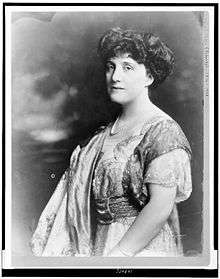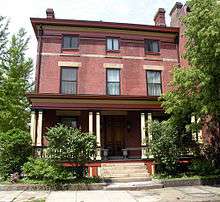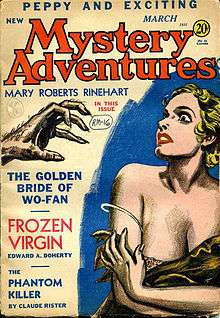Mary Roberts Rinehart
| Mary Roberts Rinehart | |
|---|---|
 Mary Roberts Rinehart (1914) | |
| Born |
Mary Ella Roberts August 12, 1876 Allegheny City, Pennsylvania |
| Died |
September 22, 1958 (aged 82) New York, New York, US |
| Occupation | Writer |
| Nationality | American |
| Genre | Mystery fiction |
Mary Roberts Rinehart (August 12, 1876 – September 22, 1958) was an American writer, often called the American Agatha Christie,[1] although her first mystery novel was published 14 years before Christie's first novel in 1922.[2]
Rinehart is considered the source of the phrase "The butler did it" from her novel The Door (1930), although the novel does not use the exact phrase. Rinehart is also considered to have invented the "Had-I-But-Known" school of mystery writing, with the publication of The Circular Staircase (1908).
She also created a costumed super-criminal called "the Bat", cited by Bob Kane as one of the inspirations for his "Batman".[3]
Biography

Mary Roberts Rinehart was born Mary Ella Roberts in Allegheny City, Pennsylvania, now a part of Pittsburgh. Her father was a frustrated inventor, and throughout her childhood, the family often had financial problems. Left-handed at a time when that was considered inappropriate, she was trained to use her right hand instead.
She attended public schools and graduated at age 16, then enrolled at the Pittsburgh Training School for Nurses at Pittsburgh Homeopathic Hospital, where she graduated in 1896. She described the experience as "all the tragedy of the world under one roof." After graduation, she married Stanley Marshall Rinehart (1867–1932), a physician she had met there. They had three sons: Stanley Jr., Alan, and Frederick.
During the stock market crash of 1903, the couple lost their savings, spurring Rinehart's efforts at writing as a way to earn income. She was 27 that year, and produced 45 short stories. In 1907, she wrote The Circular Staircase, the novel that propelled her to national fame. According to her obituary in the Pittsburgh Post-Gazette in 1958, the book sold 1.25 million copies. Her regular contributions to The Saturday Evening Post were immensely popular and helped the magazine mold American middle-class taste and manners.
In 1911, after the publication of five successful books and two plays, the Rineharts moved to Glen Osborne, Pennsylvania, where they purchased a large home at the corner of Orchard and Linden Streets called "Cassella." Before they moved into the house, however, Mrs. Rinehart had to have the house completely rebuilt, as it had fallen into disrepair. "The venture was mine, and I had put every dollar I possessed into the purchase. All week long I wrote wildly to meet the payroll and contractor costs." she wrote in her autobiography. In 1925, the Rineharts sold the house to the Marks family and the house was demolished in 1969.[4] Today, a Mary Roberts Rinehart Nature Park sits in the borough of Glen Osborne at 1414 Beaver Street, Sewickley, Pennsylvania.[5]
Rinehart's commercial success sometimes conflicted with her domestic roles of wife and mother, yet she often pursued adventure, including a job as a war correspondent for The Saturday Evening Post at the Belgian front during World War I.[6] During her time in Belgium, she interviewed Albert I of Belgium, Winston Churchill and Mary of Teck, writing of the latter, "This afternoon I am to be presented to the queen of England. I am to curtsey and to say 'Your majesty,' the first time!"[7] Rinehart was working in Europe in 1918 to report on developments to the War Department and was in Paris when the armistice was signed.[8]

In 1922, the family moved to Washington, DC, when Dr. Rinehart was appointed to a post in the Veterans Administration. She was a member of the Literary Society of Washington from 1932 to 1936.[9] Her husband died in 1932, but she continued to live in Washington until 1935, when she moved to New York City. There she helped her sons found the publishing house Farrar & Rinehart, serving as its director.
She also maintained a vacation home in Bar Harbor, Maine. In 1947, a Filipino chef who had worked for her for 25 years fired a gun at her and then attempted to slash her with knives, until other servants rescued her. The chef committed suicide in his cell the next day.
Rinehart suffered from breast cancer, which led to a radical mastectomy. She eventually went public with her story, at a time when such matters were not openly discussed. The interview "I Had Cancer" was published in a 1947 issue of the Ladies' Home Journal; in it, Rinehart encouraged women to have breast examinations.
"The Rinehart career was crowned with a Mystery Writers of America Special Award a year after she published her last novel ... and by the award, as early as 1923, of an honorary Doctorate in Literature from George Washington University."[1]
On November 9, 1956, Rinehart appeared on the CBS Television interview program Person to Person.[10] She died at age 82 at her apartment at 630 Park Avenue in New York City.[11]
Writing
Rinehart wrote hundreds of short stories, poems, travelogues and articles. Many of her books and plays were adapted for movies, such as The Bat (1926), The Bat Whispers (1930), Miss Pinkerton (1932), and The Bat (1959 remake). In 1933 RCA Victor released The Bat as one of the earliest talking book recordings. Based on Rinehart's novel Lost Ecstasy (1927), I Take This Woman (1931), starring Carole Lombard and Gary Cooper, was an early sound film based on Rinehart's works.
While many of her books were best sellers, critics were most appreciative of her murder mysteries. Rinehart, in The Circular Staircase (1908), is credited with inventing the "Had-I-But-Known" school of mystery writing. In The Circular Staircase "a middle-aged spinster is persuaded by her niece and nephew to rent a country house for the summer. The gentle, peace-loving trio is plunged into a series of crimes solved with the help of the aunt."[12] The Had-I-But-Known mystery novel is one where the principal character (frequently female) does things in connection with a crime that have the effect of prolonging the action of the novel. Ogden Nash parodied the school in his poem Don't Guess Let Me Tell You: "Sometimes the Had I But Known then what I know now I could have saved at least three lives by revealing to the Inspector the conversation I heard through that fortuitous hole in the floor."
The phrase "The butler did it," which has become a cliché, came from Rinehart's novel The Door, in which the butler actually did murder someone, although that exact phrase does not appear in the work.[13] Tim Kelly adapted Rinehart's play into a musical, The Butler Did It, Singing. This play includes five lead female roles and five lead male roles.
Works
Fiction

Novels and plays
- The Man in Lower Ten (1906)
- The Double Life (play, 1906)
- The Circular Staircase (1908)
- The Mystery of 1122 (1909)
- Seven Days (Broadway comedy, with Avery Hopwood, 1909)
- The Window at the White Cat (1910) revision of The Mystery of 1122
- When A Man Marries, or Seven Days (1910) novel version of play Seven Days
- Where There's a Will (1912)
- Cheer Up (play, 1912) produced and directed by Cecil B. DeMille
- The Cave on Thundercloud (Part of "More Tish") (1912)
- Mind Over Motor (Part of "Tish") (1912)
- The Case of Jennie Brice (1913)
- The Street of Seven Stars (1914)
- The After House: A Story of Love, Mystery and a Private Yacht (1914)
- K. (1915)
- Bab, a Sub-Deb (1916)
- Long Live the King! (1917)
- The Amazing Interlude (1918)
- Twenty-Three and a Half Hours' Leave (1918)
- Dangerous Days (1919)
- Tumble In (play, 1919) musical version of Seven Days
- Salvage (Part of "More Tish") (1919)
- A Poor Wise Man (1920)
- The Truce of God (1920)
- The Bat (play, with Avery Hopwood, 1920)
- Spanish Love (play, with Avery Hopwood, 1920)
- The Confession (1921)
- The Breaking Point (1922)
- The Breaking Point (play, 1923)
- The Red Lamp (1925)
- The Mystery Lamp (1925)
- The Bat (1926 novelization of 1920 play originally written with Avery Hopwood)
- Lost Ecstasy (1927)
- This Strange Adventure (1928)
- Two Flights Up (1928)
- The Door (1930)
- The Double Alibi (1932)
- The Album (1933)
- The State vs. Elinor Norton (1933)
- The Doctor (1936)
- The Wall (1938)
- The Great Mistake (1940)
- The Haunted Lady (1942)
- The Yellow Room (1945)
- A Light in the Window (1948)
- Episode of the Wandering Knife (1950)
- The Swimming Pool (1952)
- The Frightened Wife and Other Murder Stories (1953) (Special Edgar Award, 1954)
Series
- Miss Cornelia Van Gorder
- The Bat (1920)
- Letitia (Tish) Carberry
- The Amazing Adventures of Letitia Carberry (1911)
- Tish: The Chronicle of Her Escapades and Excursions (1916)
- More Tish (1921)
- The Book of Tish (1926)
- Tish Plays the Game (1926)
- Tish Marches On (1937)
- Hilda Adams
- The Buckled Bag (1914)
- Locked Doors (1914)
- Miss Pinkerton (1932)
- Haunted Lady (1942)
- The Secret (1950)
Short story collections
- Love Stories (1919)
- Affinities: and Other Stories (1920)
- Sight Unseen (1921)
- Temperamental People (1924)
- Nomad's Land (1926)
- The Romantics (1929)
- Mary Roberts Rinehart's Crime Book (1933)
- Married People (1937)
- Familiar Faces: Stories of People You Know (1941)
- Alibi for Isabel and Other Stories (1944)
Non-fiction
Travelogues
- Through Glacier Park in 1915 / Seeing America First with Howard Eaton (with Illustrations) (1915)[14]
- Tenting Tonight: A Chronicle of Sport and Adventure in Glacier Park and Cascade Mountains (1918) by Mary Roberts Rinehart, first published in Cosmopolitan (1917)[15]
- The Out Trail (1923)[16]
Autobiography
- Kings, Queens, and Pawns: An American Woman at the Front (1915)
- My Story (1931, revised 1948)
Essays
- "Isn't That Just Like a Man!" (1920) published in one volume together with Oh! Well! You Know How Women Are! by Irvin S. Cobb
Film and TV adaptations
- 1914 – Jane (story) – short film
- 1914 – At the Foot of the Hill (story) – short film
- 1915 – The Cave on Thunder Cloud (story) – short film
- 1915 – Mind Over Motor (novel) – short film
- 1915 – Tish's Spy (story) – short film
- 1915 – The Circular Staircase (novel)
- 1915 – Affinities (story) – short film
- 1915 – The Papered Door (story) – short film
- 1915 – What Happened to Father (story)
- 1916 – Acquitted (story)
- 1917 – Bab's Diary (story)
- 1917 – Bab's Burglar (story)
- 1917 – Bab's Matinee Idol (story)
- 1918 – The Doctor and the Woman (novel K.)
- 1918 – The Street of Seven Stars (novel)
- 1918 – Her Country First (story "The G.A.C.")
- 1919 – 23½ Hours' Leave (story)
- 1920 – Dangerous Days (novel) / (titles)
- 1920 – It's a Great Life (story "Empire Builders")
- 1922 – Affinities (story)
- 1922 – The Glorious Fool (stories "In the Pavillion" and "Twenty-Two")
- 1923 – Long Live the King (book)
- 1924 – The Silent Watcher (story "The Altar on the Hill")
- 1924 – Her Love Story (story "Her Majesty, the Queen")
- 1924 – K - The Unknown (novel K.)
- 1925 – Seven Days (play co-written with Avery Hopwood)
- 1926 – The Bat (play The Bat)
- 1927 – City of Shadows (story)
- 1927 – The Unknown (novel "K" – uncredited)
- 1927 – What Happened to Father? (story)
- 1927 – Aflame in the Sky (story)
- 1928 – Finders Keepers (story "Make Them Happy")
- 1930 – The Bat Whispers (based upon play The Bat)
- 1931 – I Take This Woman (novel Lost Ecstacy)
- 1932 – Miss Pinkerton (novel)
- 1934 – Elinor Norton (novel The State vs. Elinor Norton)
- 1935 – Mr. Cohen Takes a Walk (novel)
- 1937 – 23½ Hours Leave (story)
- 1941 – The Dog in the Orchard (story) – short film
- 1941 – The Nurse's Secret (novel Miss Pinkerton)
- 1942 – Tish (stories)
- 1952 – Robert Montgomery Presents (TV series) (novel The Wall)
- 1953 – Your Favorite Story (TV series) (story "Strange Journey")
- 1953 – Broadway Television Theatre (TV series) – The Bat
- 1956 – Star Stage (TV series) (story "I Am Her Nurse")
- 1954–56 – Ford Television Theatre (TV series) – The Unlocked Door (1954) original story/Autumn Fever (1956)
- 1954–56 – Climax! (TV series) – The After House (1954)/The Circular Staircase (1956)
- 1957 - Telephone Time (TV series) - Novel Appeal. Claudette Colbert portrayed Rinehart in the story of the genesis of the novel The After House.
- 1959 – The Bat (play) with Agnes Moorehead and Vincent Price
- 1960 – Dow Hour of Great Mysteries (TV series) – The Bat
- 1978 – Der Spinnenmörder (TV movie) based on The Bat
See also
- Crime fiction
- Detective fiction
- List of female detective characters
- List of female detective/mystery writers
- List of mystery writers
References
- 1 2 Keating, H.R.F., The Bedside Companion to Crime. New York: Mysterious Press, 1989, p. 170. ISBN 0-89296-416-2
- ↑ The Mysterious Affair at Styles
- ↑ Mary Roberts Rinehart – North American Theatre Online
- ↑ "Mary Roberts Rinehart Nature Park". mrrnaturepark.org.
- ↑ "Home: Mary Roberts Rinehart Nature Park". mrrnaturepark.org.
- ↑ MacLeod, Charlotte (1994). "Chapter 20: On Active Duty". Had She But Known: A Biography of Mary Roberts Rinehart. New York: Mysterious Press. ISBN 0-89296-444-8.
- ↑ Rinehart, Mary. "World War I Notebook – Note Pad with Cover Missing" (PDF). Special Collections Department, University of Pittsburgh. Retrieved 22 October 2013.
- ↑ Doolittle, Alice. "Mary Roberts Rinehart Papers Finding Aid". Special Collections, University of Pittsburgh. Retrieved 1 April 2013.
- ↑ Spauling, Thomas M. (1947). The Literary Society in Peace and War. Washington, D.C.: George Banta Publishing Company.
- ↑ "Person to Person Episode #4.9 (TV Episode 1956)". IMDb.
- ↑ "Mary Roberts Rinehart Is Dead; Author of Mysteries and Plays New York Times, September 23, 1958.
- ↑ Roseman, Mill et al. Detectionary. New York: Overlook Press, 1971. ISBN 0-87951-041-2
- ↑ "The Straight Dope: In whodunits, "the butler did it." Who did it first?". straightdope.com.
- ↑ Roberts Rinehart, Mary (1915). Through Glacier Park in 1915 / Seeing America first with Howard Eaton (With Illustrations). Roberts Rinehart Publishers.
- ↑ Roberts Rinehart, Mary (1918). Tenting Tonight: A Chronicle of Sport and Adventure in Glacier Park and Cascade Mountains, with Illustrations.
- ↑ Roberts Rinehart, Mary (1923). The Out Trail.
Further reading
- Mary Roberts Rinehart Papers (Mary Roberts Rinehart Papers, 1831-1970, SC.1958.03, Special Collections Department, University of Pittsburgh)
- MacLeod, Charlotte (1994). Had She But Known: A Biography of Mary Roberts Rinehart. New York: Mysterious Press. ISBN 0-89296-444-8.
- Cohn, Jan (2005) [1980]. Improbable Fiction: The Life of Mary Roberts Rinehart. Pittsburgh: University of Pittsburgh Press. ISBN 0-8229-5912-7.
External links
| Wikimedia Commons has media related to Mary Roberts Rinehart. |
| Wikisource has original text related to this article: |
| Library resources about Mary Roberts Rinehart |
| By Mary Roberts Rinehart |
|---|
- Mary Roberts Rinehart at the Internet Movie Database
- Mary Roberts Rinehart at the Internet Broadway Database

- Mary Roberts Rinehart Nature Park (Glen Osbourne, PA) with picture of "Casella" (demolished 1969)
- Mary Roberts Rinehart at University of Pittsburgh digital library
- Works by Mary Roberts Rinehart at Project Gutenberg
- Works by or about Mary Roberts Rinehart at Internet Archive
- Works by Mary Roberts Rinehart at LibriVox (public domain audiobooks)

- Mary Roberts Rinehart at Library of Congress Authorities, with 127 catalog records